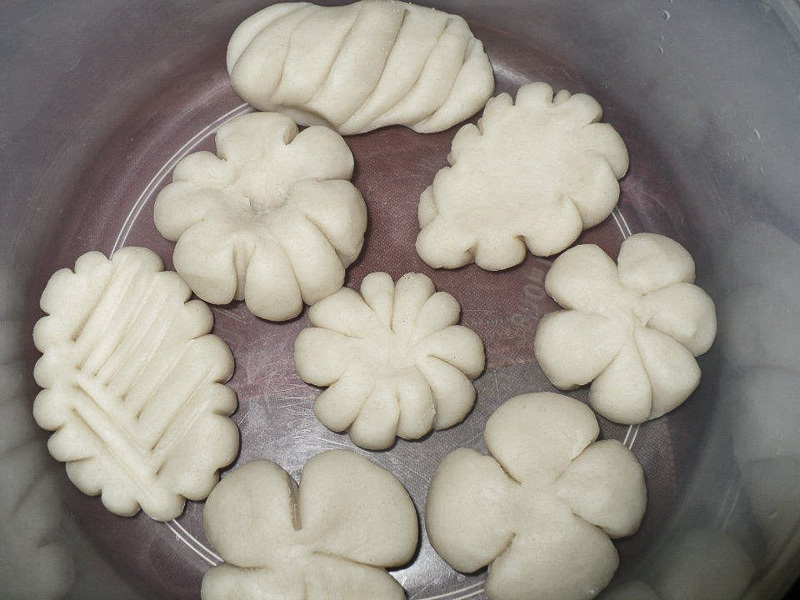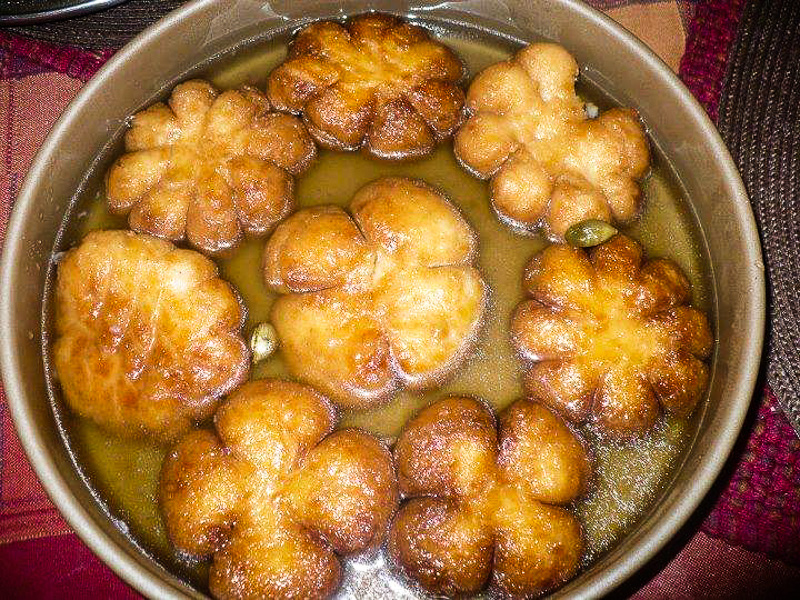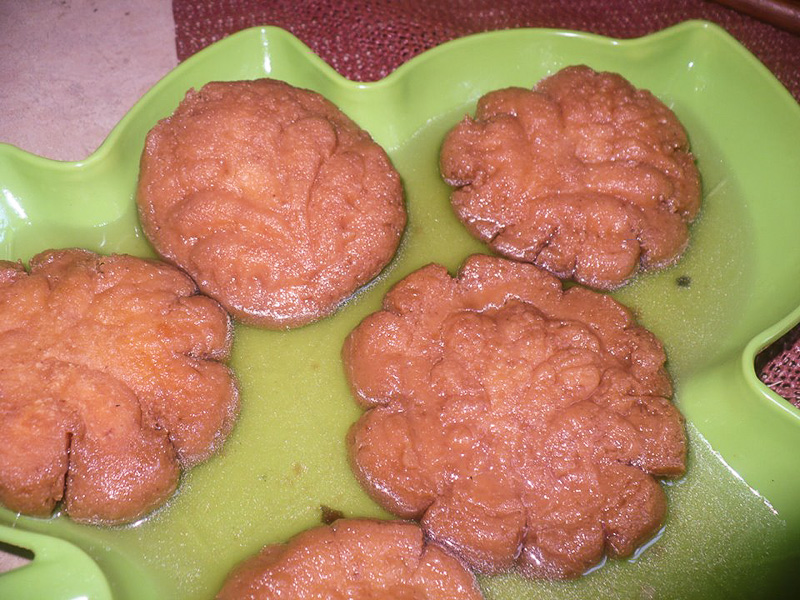Before I started blogging, or even before I ever thought of starting a blog, I loved cooking. Naturally, this love led me to join few cooking groups on Facebook. I came across many foodies through the Facebook group and Khadiza stood out from out of the 10k+ members. Her recipes are authentic, flavorful and delicious. Her personality is humble and helpful. Couple years ago she started her own Facebook cooking group and it is one of the most successful cooking groups for Bangladeshis. Recently, Khadiza started her own blog, Khadiza’s Kitchen featuring mouthwatering, authentic, Bangladeshi cuisine.
As the weather turns chillier on the northern hemisphere, it is time for pitha in Bangladesh. When I asked Khadiza if she’ll do a pitha post for my blog, she graciously accepted to write a guest post. I will share some info about pitha’s at a later post, but now, let’s turn to Khadiza to find out what deliscious pitha she presented all of you.
***
This is my very first guest post and it’s for a very good food buddy of mine, very talented, a very sweet but strong personality, Lail S Hossain, of With a Spin!!!!!!
Bangladesh, the land of Pitha-puli , has at least hundreds different types of pithas, taste, recipe varying region to region. Most of the pithas are either seasonal or occasional. Some are associated with harvest festival (nobanno) in winter while some others are prepared for any special occasion like wedding, eid or puja. Some are crunchy, some are steamed and some are so delightfully soaked in sugar syrup, molasses syrup , milk or date palm sap . Most of them are sweet, though there are some savory pithas too.
Shirgoja is a traditional pitha of greater Barisal region of Bangladesh. It’s an occasional one. From childhood it has been the most adored pitha to me. Involves few techniques to make it perfect. Let’s move on to the recipe and the techniques. Shall we?
- 1 cup all purpose flour
- 1 cup Milk
- 1 beaten egg
- 2 table spoon of breadcrumbs
- Pinch of salt
- 1½ tablespoon Ghee/ oil
- Oil for frying
- For Sugar Syrup:
- 1 cup sugar
- 1½ cup water
- 1 piece cinnamon, about 2”
- 3 green cardamoms
- Make thin sugar syrup with sugar, water, cinnamon and cardamom. Set aside.
- Boil milk. Add a pinch of salt, and flour and mix. Form dough like dough for roti or chapatti.
- Transfer the dough to a bowl. Knead well.
- Add the ghee or oil.
- When the dough cools a bit add the beaten egg and breadcrumbs. Knead well. You may find it difficult to incorporate everything smoothly but keep kneading. You may need to add some extra breadcrumb to work comfortably with the dough.
- The kneading part is very important. The smoother and glossy dough you can make by kneading, the softer pitha you will get after soaking in the syrup.
- Now make round balls and shape them with special dice. You can shape them without the dice using a cookie cutter. Better yet, just apply some imagination and your artistic mind to design small pieces of pitha.
- Heat enough oil in a pot so pithas can be deep-fried. Now, the frying part is very important. If not fried well, the pithas will remain hard, especially in the center, even in the sugar syrup. The oil must be heated on medium low flame and it must not be too hot. Too hot oil will make the pithas get the outer color fast but leaving the center raw. The oil must not be cold either. Carefully, heat oil on medium low heat and fry the pithas well until dark golden brown.
- Transfer the pithas into lukewarm sugar syrup and soak them for at least ⅞ hours. If soaked well, the pithas will be soft like gulabjamun or laalmohon.
While frying, the temperature of the oil must be perfect. It should neither be too hot or mild hot. If it is too hot the pithas will go dark brown without being cooked in the center. And if oil is little hot the pithas will absorb a lot of oil and will taste bad. Therefore, oil should be heated on the same temperature from beginning to end. It should be on low medium heat and bubble should occur when you add the pithas. Remember oil should not be so hot that smoke can be seen. Also, remember to fry them with patience, with more time, so that they are perfectly fried inside out.
Always put the pithas in luke warm syrup. If you put them on piping hot syrup, the texture of the pitha will be ruined.





What gorgeous, mouthwatering fritters, Lail! Khadiza did a great job!!!
Thank you, Denise. Khadiza is an awesome cook and did great with the shirgoja.
<3
Thank you for the lovely Pithas, Khadiza.
OMG These are like beautiful gulab jamuns!
Must make them.
You got it my friends. These are almost like artistic gulab jamuns.
Wow! looks tasty. Am off to google “pitha” 🙂
These are gorgeous gulab jamuns, they are so artistic and just.. wow 😀
Cheers
CCU
They are, Uru. Khadiza did a wonderful job. Can’t wait to try them.
Tasty looking guest post!
You are right. Tasty it is 🙂
Thank you!
Thank you so much for all your lovely comments ! 🙂
Looks so tempting and festive!
They do, right? Thanks, Kiran.
Thanks a lot for this great recipe. I have a question about this pitha. Is it ok, if I made this pitha at night and fry it in the morning? It will be helpful if you kindly give the answer.
Hi Jane – It’s better to fry the pitha and soak in syrup overnight. If making the pithas and not frying immediately, they can dry out. This will result in a not so soft pitha. Hope this helps.
Not being rude or anything but I followed the exact recipe amounts but was a total disaster.sumthing wrong with the amounts mentioned.plz check
Hi Elora. This was a guest post from a friend, Khadiza of Khadiza’s Kitchen, and not my recipe. Can you please let us know what went wrong? In the mean time I am notifying her so she can address your concerns. Thank you for your feedback.
Hello Elora , I too am curious to know , what went wrong !! I don’t think there is any problem with the measurement .. many tried the recipe and I got good feedback … but yes , the syrup might need little more water , like 2 cups , instead of 1 and 1/2 .
Okay now the important ponts;
# how did you knead it ?? is it glossy enough and smooth??
# How did you fry it ??? It needs to be fried very well , for a longer period and evenly . How was your oil ?? too hot or not so hot can create problem.
# How was your sugar syrup ?? It needs to be thin , one string consistency. If the syrup is thick , the pithas won’t absorb the syrup and will remain hard .
# When did you put the pithas on the syrup?? Did you put them immediately after frying into warm syrup ??? If not , then it may create a problem .
Thank you .